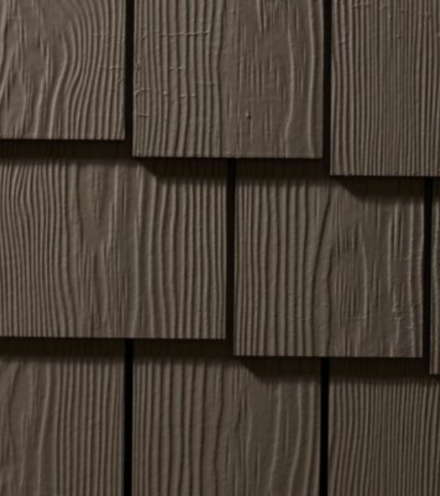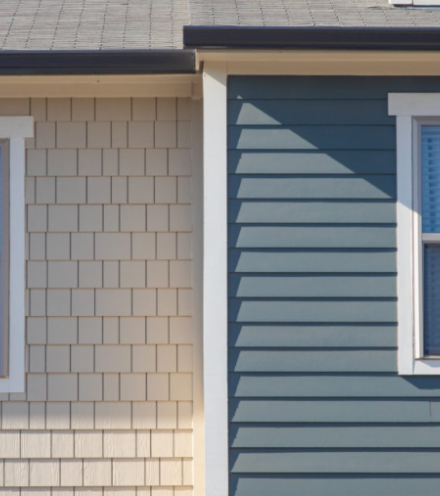Soffit and fascia are essential parts of any home exterior. Though commonly used, aluminum soffit panels aren’t always the best option for sealing off the eaves.
Before settling for aluminum soffit panels for your home or business, be sure to familiarize yourself with the drawbacks, risks, and maintenance needs of this material option and learn about an alternative product that delivers better durability and long-lasting beauty.
How to Identify Aluminum Soffit Panels
Soffit is an important component of exterior trim. Similar to fascia panels, which cover the vertical edge of the roofline, soffit panels cover the underside of the eaves. Without soffit, the eaves would be entirely exposed, opening up the roof, attic, and other exterior spaces to excess contact with the elements – including moisture from rainwater and pests that are looking to build a cozy nest.
Buildings with large roof overhangs will have more surface area to cover and require more soffit, but every building still needs this essential piece of exterior trim. In addition to providing a stylish trim to make the home look finished and complete, soffit serves practical purposes as well. As mentioned, soffit panels seal off the underside of the roof overhang, which adds an extra layer of protection from the elements.

Why Are Some Aluminum Soffit Panels Vented?
Soffit also plays an important role in energy efficiency. You may have noticed that some aluminum soffit panels are vented, meaning that they have little holes in them, while others feature a smooth surface. Vented aluminum soffit panels – also referred to as perforated aluminum soffit panels – are used to boost airflow and help the attic maintain an ideal temperature.
It’s not just aluminum soffit panels that can be found with a ventilated design. Most modern soffit materials feature both smooth and perforated options to help builders construct the precise ventilation strategy needed for their particular building project. Some even prefer a combination of vented soffit and smooth soffit to manage energy efficiency needs.
Soffit Aluminum Panels Come with Drawbacks
Now, let’s talk about the material options on the market. Many people opt for aluminum soffit panels because it seems like the standard choice. But it’s important to note that there are other options to consider – one of which in particular provides much better long-term value than aluminum.
After all, aluminum soffit can have several drawbacks. Because it’s made from metal, homeowners often assume that aluminum soffit panels are super durable. Unfortunately, that isn’t the case. The type of aluminum used for soffit tends to be a low grade metal that is incredibly thin – sometimes even hollow – which means dents and dings can happen quite easily, even from everyday occurrences, like hail or fallen branches from nearby trees. Though putty can help address damage on aluminum soffit panels, it never quite looks the same.
Another issue with aluminum soffit is the overall upkeep needed to maintain its appearance. On top of addressing dents and dings, aluminum soffit panels can fade quickly with prolonged sun exposure. Though it doesn’t seem like a big deal, color fading, chipped paint, and other aesthetic issues can dramatically drag down the overall curb appeal of the home. Climbing up on a ladder to try and maintain the appearance of aluminum soffit can be tedious and tiring, which usually leads homeowners to look for an easier alternative.

A Stronger, Low-Maintenance Alternative
Built with a strong core composed of cement, sand, and cellulose fibers, fiber cement soffit provides the pure strength and durability needed to offer long-lasting beauty. Unlike thin aluminum soffit panels, fiber cement has a solid core with a ¼-inch thickness, which makes damage rare. In fact, the quality of fiber cement soffit even makes it appropriate for use in other overhead spaces, like porch ceilings.
When it comes to exterior trim materials, durability and longevity are everything. In most cases, the stronger the material, the longer it will last. This translates into much less upkeep and maintenance, as well as fewer costs to address repairs.
Fiber cement soffit is sold in a wide range of colors and designs, including vented soffit panels and smooth soffit panels. This makes it easy to design the perfect ventilation and airflow strategy for your home. Choose from traditional soffit panels with authentic-looking wood grain patterns or those with a smooth, clean surface for a more modern style.
Strong, low-maintenance, and built with an attractive design, fiber cement is a better alternative to aluminum soffit panels. Contact Allura today to explore fiber cement soffit, beadboard, and other exterior solutions to enhance your home.




